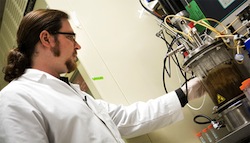Several University of Michigan researchers have joined together a fungus and E. coli bacteria to turn tough, waste plant material into isobutanol – a product that can be converted into biochemicals and biofuels. A paper based on this research, “Design and characterization of synthetic fungal-bacterial consortia for direct production of isobutanol from cellulosic biomass,” was published in The Proceedings of the National Academy of Sciences.
Xiaoxia “Nina” Lin, assistant professor of chemical engineering, and leader of the research said her team used corn stalks and leaves to produce the isobutanol. Focused on creating a super team of microbial specialists, the team landed on the fungus Trichoderma reesei, an up and coming star when its comes breaking down tough plant material into sugars. Escherichia coli, meanwhile, is relatively easy for researchers to genetically modify and the team used a strain developed by James Liao’s lab at the University of California – Los Angeles that had been engineered to convert sugars into isobutanol.
The Lin group put both microbe species into a bioreactor and served up corn stalks and leaves. Colleagues at Michigan State University had pre-treated the roughage to make it easier to digest. “If you’ve ever had puffed rice cereal, it’s somewhat analogous,” said Jeremy Minty, first author of the paper and a recent doctoral graduate in Lin’s lab.
The fungi turned the roughage into sugars that fed both microbe species with enough left over to produce isobutanol. The team managed to get 1.88 grams of isobutanol per liter of fluid in the ecosystem, the highest concentration reported to date for turning tough plant materials into biofuels. They also converted a large proportion of the energy locked in the corn stalks and leaves to isobutanol – 62 percent of the theoretical maximum.
The harmonious coexistence of the fungi and bacteria, with stable populations, was a key success of the experiment. “A lot of times, one species will dominate the culture and the  other will die off,” explained Minty. “This is a common problem when you’re trying to create these systems.”
other will die off,” explained Minty. “This is a common problem when you’re trying to create these systems.”
Convincing the microbes to play nicely pays off added Lin. “You can put everything in one pot. The capital investment will be much lower, and also the operating cost will be much lower, so hopefully this will make the whole process much more likely to become economically viable.”
Minty and others in Lin’s group are now trying to improve on their energy conversion rate and increase the tolerance of the T. reesei and E. coli to isobutanol. The fuel is toxic, but higher concentrations will drive down the cost of isolating the fuel.

